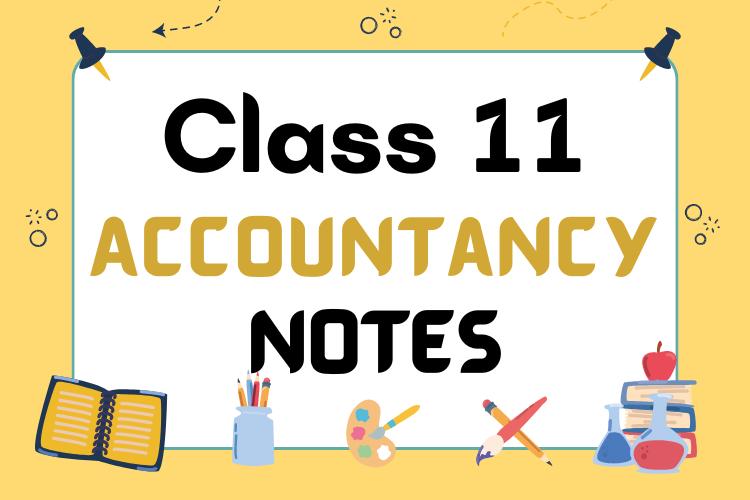
CBSE Class 11 Accountancy Notes:
Class 11 Accountancy students learn a great deal of concepts and principles about accounting, making it a significant topic. Comprehensive study materials are necessary for this subject. To review each chapter and retain the material, students will require the notes.
The free CBSE Class 11 Accountancy Notes PDF is a valuable resource for any student enrolled in the CBSE Class 11 who wants to excel in accounting. The purpose of these study materials is to ensure that using them will result in the highest exam score.
These revision notes are developed by the latest CBSE rules, which are mandatory for all students in Class 11. Since they lay the groundwork for all students at this level, these notes should be carefully studied. You can download the CBSE Class 11 Accountancy Notes PDF, chapter by chapter, from the CHK website or app on your smartphone.
Download and refer to the CBSE Class 11 Accountancy Notes from the CHK experts for revision. Gain a faster understanding and retention of material to perform well on tests.
CBSE Class 11 Accountancy Notes
It is important for students in class 11 to comprehend accountancy because it deals with fundamental accounting concepts. Acquiring proficiency in this area provides a solid basis and facilitates understanding of more advanced subjects such as trial balance, bank reconciliation, depreciation, reserves, and computerised accounting systems. Concise and thorough study materials for simple comprehension and efficient revision are provided in our CBSE Class 11 Accountancy Notes PDF.
CBSE Class 11 Accountancy Notes PDFs Download
Use the links below to download the CBSE Class 11 Accountancy Notes PDF chapter-by-chapter for free:
| Chapter 1 | Introduction to Accounting | CLICK HERE |
| Chapter 2 | Theory Base of Accounting | CLICK HERE |
| Chapter 3 | Accounting Equation | CLICK HERE |
| Chapter 4 | Journal and GST | CLICK HERE |
| Chapter 5 | Cash Book | CLICK HERE |
| Chapter 6 | Subsidiary Books | CLICK HERE |
| Chapter 7 | Ledger | CLICK HERE |
| Chapter 8 | Bank Reconciliation Statement | CLICK HERE |
| Chapter 9 | Depreciation, Provisions and Reserves | CLICK HERE |
| Chapter 10 | TRIAL BALANCE | CLICK HERE |
| Chapter 11 | RECTIFICATION OF ERRORS | CLICK HERE |
| Chapter 12 | FINANCIAL STATEMENTS OF SOLE PROPRIETORSHIP | CLICK HERE |
| Chapter 13 | Financial Statements Adjustments | CLICK HERE |
Chapter 1 Introduction to Accounting
This chapter serves as an introduction to the field of accounting. It goes deep into the fundamental aspects of accounting. Specifically created for Class 11th Accountancy, this chapter discusses key concepts such as accounting information and its diverse user base.
The included notes extend on essential accounting terms like capital, profit, loss, drawings, purchase, sale, etc., aiming to establish a strong basis for learners, enabling a better understanding of subsequent chapters.
Chapter 2 Theory Base of Accounting
The fundamentals of accounting and accounting standards are covered in the second chapter of Class 11th Accountancy Part-A.
The notes additionally cover over the fundamental and key accounting topics in depth, such as Business Entity Concept, Going Concern Concept, Cost Concept, Matching Concept, and many more. The notes also cover another important subject for understanding the concept of accounting, Single and Double Entry Systems of Accounting.
Chapter 3 Accounting Equation
A business’s assets are always equal to its total capital and liabilities, as demonstrated by the Accounting Equation. CBSE Class 11 Accounting Equation Notes covers all the important topics and concepts as mentioned in the chapter.
Chapter 4 Journal and GST
Class 11 Chapter 4 Journal and GST notes of Accounting are crucial study tools that will aid students in understanding the topic. The chapter 4 Journal and GST notes for class 11 accounts include a thorough overview of the chapter in addition to practice papers, brief keynotes, solved problems and revision notes to help with test preparation.
All of the important topics, including the Cash Book, Purchases Return (Return Outwards), Purchases Book, Sales, Sales Return Book (Return Inwards), and Journal Proper, Explanation of Goods and Services Tax (GST), working of GST, different types of GST, objectives, features, advantages of GST etc. are covered and briefly discussed in this chapter.
Chapter 5 Cash Book
A cash book is a journal in which receipts and payments made in cash or through banks are recorded. Cash books are mainly of 4 types, and it is a double-entry system. All important topics such as single column triple column etc are covered in it.
Chapter 6 Subsidiary Books
All subsidiary books are essentially an arrangement for keeping track of transactions that are similar in character. Journal divisions are called subsidiary books. CBSE Class 11 Subsidiary Books Notes has everything there is to know about these books, including their functions, and the several kinds of subsidiary volumes.
Chapter 7 Ledger
The book which contains a classified and permanent record of all the transactions of a business is called Ledger. CBSE Class 11 Ledger notes cover ledger posting and its examples, the steps involved, the significance of ledgers, and other key elements.
Chapter 8 Bank Reconciliation Statement
The Bank Reconciliation Statement chapter in Class 11 Accountancy is essential for teaching students about this important topic. It also establishes the conceptual foundation and clarifies the various phrases and concepts associated with this topic. Read the concise notes created by CHK’s subject matter specialists to improve this process. To study properly and get higher exam scores, work through the condensed version of the entire chapter that is covered in Bank Reconciliation Statement notes.
The Bank Reconciliation Statement notes for Class 11 are among the most well-crafted and exam-focused materials created by CHK’s highly qualified teachers.
Chapter 9 Depreciation, Provisions, and Reserves Notes
Class 11 depreciation, provisions, and reserves notes explained the understanding depreciation, its causes, and its techniques. It also covers any expansion or addition to the current assets as well as their disposal. The necessity of depreciation and the variables influencing its quantity are also covered in this chapter. It also describes reserves, declining charge method, provision, and other depreciation techniques.
These notes can be utilised by students as a last-minute review resource right before exams, as well as an effective exam preparation tool. The CHK website provides access to these notes at any time.
Chapter 10 Trial Balance
A trial balance is a statement showing balances, credit, and debit totals of the ledger account to offer accuracy. This chapter is very important since it is used in banking and other industries where people have to keep accurate records of their business transactions. Class 11 Trial Balance Notes covers all the important topics in a clear and concise manner.
Because of the significance of the chapter, we carefully considered the level of readiness that the class 11 students should acquire in order to provide a solid foundation for their class 11 exams when creating our revision notes.
Chapter 11 Rectification of Errors
Rectification of errors is referred to as the procedure of revising mistakes made in recording transactions. A crucial chapter in the study of class 11 accountancy is Rectification of Errors. Therefore, our teachers and experts in the field have put together the class 11 Accountancy Rectification of Errors Notes.
Class 11 Rectification of Errors notes are regarded to be a written summary. This summary provides a concise overview of all topics, concepts, entries, and so on. Students can effortlessly do last-minute revisions with the Class 11 Accountancy Notes.
Chapter 12 Financial Statements of Sole Proprietorship
We’re providing the best Class 11 Financial Statements Notes made by CHK Experts. Financial Statements of Sole Proprietorship is a crucial chapter for class 11 and further higher education in this topic. These financial statements are the final statements that all firms prepare at the end of their fiscal year.
Exam questions on Class 11 Accountancy Financial Statements of Sole Proprietorship are often focused on this important subject. Class 11 Accountancy Notes covers every major topics such as trading and profit and loss accounts; a balance sheet etc. This notes covers all of these topics comprehensively.
Chapter 13 Financial Statements Adjustments
The concepts of passing adjustment entries have been explained in an understandable way in CHK’s Class 11 Financial Statements Adjustments Notes. To correctly adjust the books accounts, a variety of adjustments, such as bad debts, accrued income, provision for dubious debts, and prepaid expenses, must be approved at the end of the year or each month.
To enhance their preparation for this chapter, students can refer to the CBSE Class 11 Financial Statements Adjustments Notes by CHK.
Importance of Class 11 Accountancy Notes
- Vital for finishing the curriculum quickly.
- Includes a broad range of subjects such as trial balance, bank statements, and accounting.
- Examines the concepts, practices, and aspects of accounting and the financial industry.
- Encourages in-depth comprehension of chapters in order to provide insightful answers to textbook questions and achieve high test scores.
- A significant portion of the eleventh-grade curriculum.
- Aids in improving comprehension of the CBSE system.
- increases students’ ability to respond to questions and perform well on tests.
- Views into forms for answering questions in accordance with CBSE guidelines.
- Written by CHK specialists, offering comprehensive understanding of fundamental concepts.
- Helps students organise a successful study strategy for chapters and exam performance.
CBSE Class 11 Accountancy Notes FAQs
Q1. “Are there 2 books in accountancy class 11?”
Ans. “Typically, Class 11 Accountancy is covered in two parts or books, namely ‘Financial Accounting Part 1’ and ‘Financial Accounting Part 2.”
Q2. “Who is the father of accountancy?”
Ans. “Luca Pacioli is known as the “Father of Accounting” for his groundbreaking work in the 15th century, during which he invented the double-entry accounting system. ”
Q3. “What is the golden accounting rule?”
Ans. “As stated in the Golden Rule of Accounting, “Debit what comes in, credit what goes out.” It highlights the system of double entry.”
Q4. “What is a cash book?”
Ans. “A cash book is a type of financial journal used to keep a record of all business cash transactions, including payments and receipts.”
Q5. “What is debit and credit?”
Ans. “Credit usually denotes an increase in liabilities, income, or capital, whereas debit usually denotes an increase in assets or expenses.”
for more information contact us –
Ph. No. – +91-6367885579
WhatsApp – Click to chat
facebook – @commercehubkota
Instagram – @comerc_classes
Youtube – @commercehubkota
Telegram – @comerc.in



